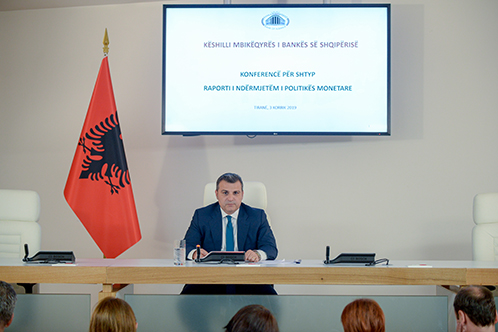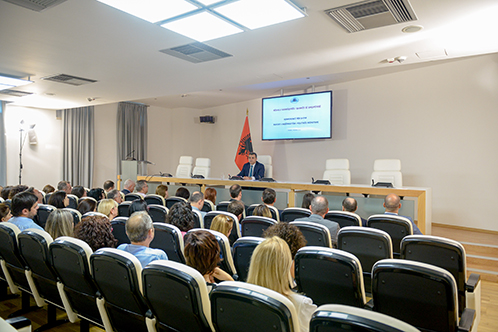BANK OF ALBANIA
PRESS RELEASE
Governor Sejko: Statement to the Press Conference on Monetary Policy Decision, 3 July 2019
Publication date: 03.07.2019
Dear Ladies and Gentlemen,
Today, on 3 July 2019, the Supervisory Council of the Bank of Albania reviewed and approved the Intermediate Monetary Policy Report.
The new analysed information has been on the down side of our expectations. The Albanian economy continued to grow over the first two quarters, albeit at a slower pace compared with the previous year. Inflation continues to undershoot the central bank target, mainly as a result of the decelerating effect from the rapid appreciation of the exchange rate in the previous year. Conversely, monetary conditions appear stimulating and credit activity has shown signs of recovery. Our projections for the outlook have not changed significantly, although downside risks have risen.

Against this backdrop, the Supervisory Council judged that the current accommodative monetary policy stance remains adequate for guaranteeing the convergence of inflation towards our target, over the medium term.
Let me now explain our assessment in greater detail.
***
In line with our expectations, inflation pursued an upward trajectory in April and May, standing at 1.4% and 1.5%, respectively. Over the last months, inflation has reflected mainly the volatility in food prices and oil prices.
From the macroeconomic perspective, inflation undershooting continues to reflect a still sluggish growth in wages and production costs in the economy, low inflation rates in our trading partners and the residual effect from the exchange rate appreciation in 2018. Based on the observed trends, the Supervisory Council deems that both domestic and imported inflationary pressures will converge gradually toward our inflation target over the next two years.

According to Instat data, economic activity in Albania grew 2.2% in the first quarter of 2019. The pace of growth slowed down mainly on account of the contraction in the production and export of electrical energy. Indirect available data suggest the Albanian economy will perform similarly in the second quarter as well. In terms of aggregate demand, economic growth continues to be underpinned by consumption and investments, while the deficit of international trade has widened and fiscal policy continues to maintain a consolidation stance. Overall, economic growth for 2019 is expected to be slower than in the previous year, reflecting supply-side shocks from the contraction in electrical energy production.
Though the pace of growth slowed down, employment and wages were upward in the first quarter. According to Instat data, the unemployment rate fell to 12.1%, and the average wage recorded 4.9% annual growth. Such a performance creates the premises for faster increase in domestic inflation, hence contributing to the convergence of inflation to target.
The accommodative monetary policy was aligned with the fiscal consolidation, creating a financial environment characterised by low interest rates, ample liquidity and downward risk premia. The monetary stimulus has reduced costs of financing the private sector, has supported the growth of credit, consumption and investments, and has created conditions for a calm performance of the exchange rate. The latter has been on a slight appreciation trend over the second quarter, in line with its seasonal behaviour. Yet, foreign trade data and a calm performance of the exchange rate suggest that the duration and intensity of the exchange rate appreciation will remain limited. As a result, its decelerating effect on inflation will be gradually diminishing.
Favourable credit conditions have sustained a stable growth of credit to the private sector. Adjusted for loan write offs and exchange rate, credit to the private sector recorded around 6.7%, annual growth, in April and May. Expansion of the credit portfolio was more balanced in terms of currency structure as well as beneficiaries, registering expansion in both credit to households and credit to enterprises. Albeit moderate, growth of credit to enterprises is a positive signal related to the improvement in credit supply and demand. The return of the NPL ratio to a downward trend, as illustrated by its fall to 11.37% in May, provides encouraging signals on the further improvement of the credit environment and balance sheets of the banking sector.
Judging by the current development trends, and their determining factors, the Bank of Albania deems that the aggregate demand will be upward during the medium-term horizon. The expansion of economic activity will enable full utilisation of production capacities and is expected to generate employment growth and faster increase in wages and production costs. Inflation is expected to converge towards our target by 2021 H1.
Downside risks remain predominant and have strengthened even further. They pertain to the external environment, exchange rate performance and its effect on inflation, the capability of credit supply to respond to the expected improvement in demand, and, lastly, the political situation in the country. The prolonged political disputes in the country would be reflected in the business climate and may affect economic activity.
***
Based on these considerations, the Supervisory Council deems that the monetary policy stance will remain accommodative in the medium-term horizon. In this meeting, it decided to:
- Keep the policy rate unchanged, at 1.0%;
- Keep the overnight deposit and overnight lending rates, unchanged at 0.1% and 1.9%, respectively.
The monetary policy stance will remain accommodative over the medium term. The intensity of the monetary stimulus will be adjusted for the speed and steadiness of economic activity improvement. The Bank of Albania remains ready to respond to potential shocks in order to ensure achieving the inflation target.

 Twitter
Twitter
 Youtube
Youtube
 Facebook
Facebook
 Flickr
Flickr
 RSS
RSS
 Subscribe
Subscribe
 Feedback
Feedback